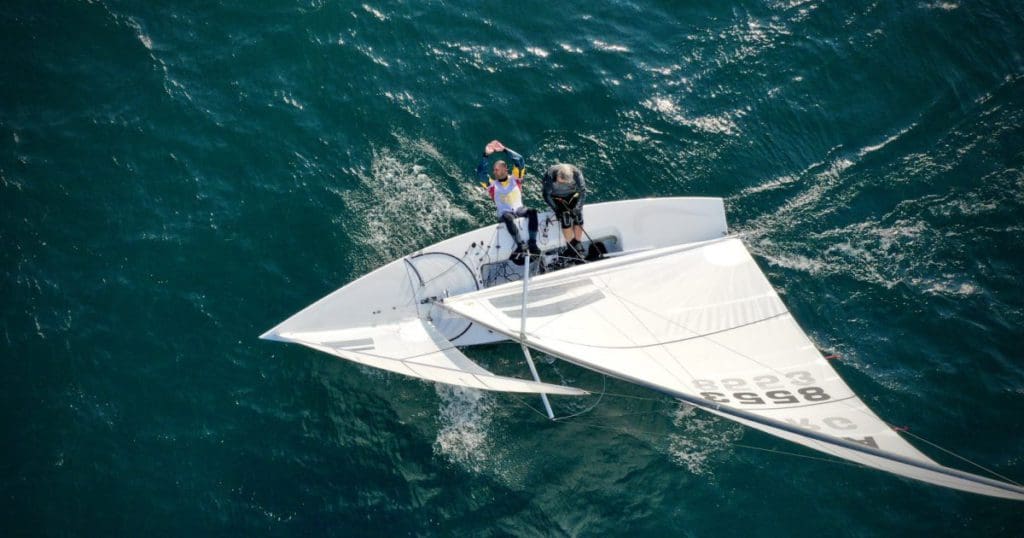Legendary sailor Skip Dieball joined Doyle Sails last month, offering a fresh face to Chicago and Detroit sailors. Skip’s one of the most accomplished and respected sailors in the US – a true sailing expert offering design, manufacture and sailing expertise to all sailors, from One Design classes and cruising yachts through to Grand Prix race yachts.
To celebrate this legend coming on board, Skip is providing us with some top tips over the coming months.
In our second installment of Tips from Skips, we explore sailing upwind in the breeze.

Sailing upwind in breeze can be a hand full. The boat is nimble, responsive and very lively. Because of this all manoeuvres should be calculated and communicated to the crew to ensure good teamwork, but more importantly to avoid disaster!
For the driver, it means constant attention to the “feel” of the boat (helm, balance, etc.). For the crew it is assisting in the boat’s set up and hiking (which is, unfortunately, not the more comfortable things to do).
To achieve good upwind performance in the breeze, you need to focus on three things:
- Mainsail set up
- Sail Entry (both main & jib)
- Slot
MAINSAIL SET UP
The first thing I do when sailing upwind in breeze upwind is see how the mainsail is reacting to mainsheet trim. To do this, I’ll start testing the range in which I can feel the boat load up (by trimming in) and then finding the spot that the boat becomes more controlled (by easing out). This range gives me an idea of what I have in store for the day. My goal, from this point, is to lessen that range of trim by pulling on controls.
The controls that I focus on with de-powering the mainsail is 1) Outhaul; 2) Vang; 3) Cunningham/Main Halyard. I would add a 4th, the TRAVELER, but I don’t use it. I recognize that this is my preference and my style, so please, if you use your traveler, add it to the list and use it to its full effectiveness.
Regarding the Outhaul, I usually tell people there are two settings: Tight and REALLY Tight. In anything where the boat is fully loaded, we pull the Outhaul on REALLY Tight. This keeps the bottom 1/3 of the sail flat and slot nicely open.
The Vang is the next control, and arguably the control that I use the most to de-power the boat. By pulling on the vang, you induce bend into the mast. This cause/effect situation flattens the mainsail, thus making the boat less powered. The amount of vang varies greatly on two things: 1) Wind Speed and 2) Sea State. If the wind is up in the upper teens to twenties, I’ll have it on as hard as I can pull it. This is pretty hard! If the boat is marginally loaded and there are big waves, I will have it between ½ and ¾ on. In my opinion, the vang is used as an extension of the mainsheet in that when you feel the need to ease the main to get the boat back rolling, the vang typically comes on.
The Cunningham historically has only been used as the breeze comes up to keep the mainsail from having too many overbend wrinkles. If you are going through the motions of pulling on the vang and bending the mast, you’ll definitely see a surplus of overbend wrinkles. This is a sign that the draft is moving aft through the mast bend and by pulling on the Cunningham, you are essentially pulling the draft forward, but more importantly you are “cleaning up the leech”. By this I mean the process of pulling the draft forward is allowing the leech to stand straight again.
SAIL ENTRY
Just as I was mentioning the Cunningham and managing the overbend wrinkles, you also have to pay attention to the jib luff. If you have the jib luff set too lightly in the breeze, the draft will be pushed aft, the leech will hook in and the steering groove will be too fine. By pulling on the jib cloth, or halyard tensioner, you are doing much of what you would by pulling on the mainsail Cunningham…moving the draft forward, cleaning up the leech and creating a nice driving entry into the jib.
SLOT
The slot between the main and jib is very critical to manage as you sail through the ranges. Ideally, you’ll want as symmetrical of a slot from top to bottom as possible. If you are like me, however, and ease the main and vang sheet hard, that slot can sometimes get too closed off. There are two things you can do to make the opening between the main and jib bigger: 1) Slide the jib leads aft; 2) East the jib sheet. I tend to do more of #2 because 1” of jib sheet is equal to a whole lot of jib lead aft (twist). You have to be careful to not sail too loose if the wind drops off. That is why you need to continually monitor the two reference points: 1) Leech off the middle spreader (typically 1”-3”in breeze); 2) where the foot of the jib lies in relation to the rail.
The performance of sails is key to the success of any sailing, be it enjoying a day sail on the lake or a Grand Prix race event. Here at Doyle Sails we are experts in making your sailing as good as it can be, taking pride in showcasing this through our many happy owners and successful campaigns. Skip joins Doyle Sails immediately, he is your new local Doyle Sails expert, facilitating all new sail needs, alongside coordinating any maintenance required for your current Doyle sails.

